International Finance Report: Risk, Investment, and Regulations
VerifiedAdded on 2020/06/06
|6
|1338
|31
Report
AI Summary
This report on international finance addresses various aspects of international financial management. It begins by examining the exposure to exchange rate risk when investing in China and financing through Australian banks, highlighting the impact of exchange rate fluctuations on debt finance. The report then delves into the use of capital budgeting for comparing Australia and China-based projects, considering different currencies and interest rates. It discusses the cost of equity versus debt, and the implications of currency in borrowing. Factors determining currency selection, such as inflation rates, current account deficits, and public debt, are analyzed. The report also outlines crucial factors for short-term investments in Australia and China, including economic growth rates, economic forecasts, stock market performance, and global economic conditions. Finally, it explores the impact of regulations related to fund transfers on investment decisions, referencing relevant literature to support its findings.
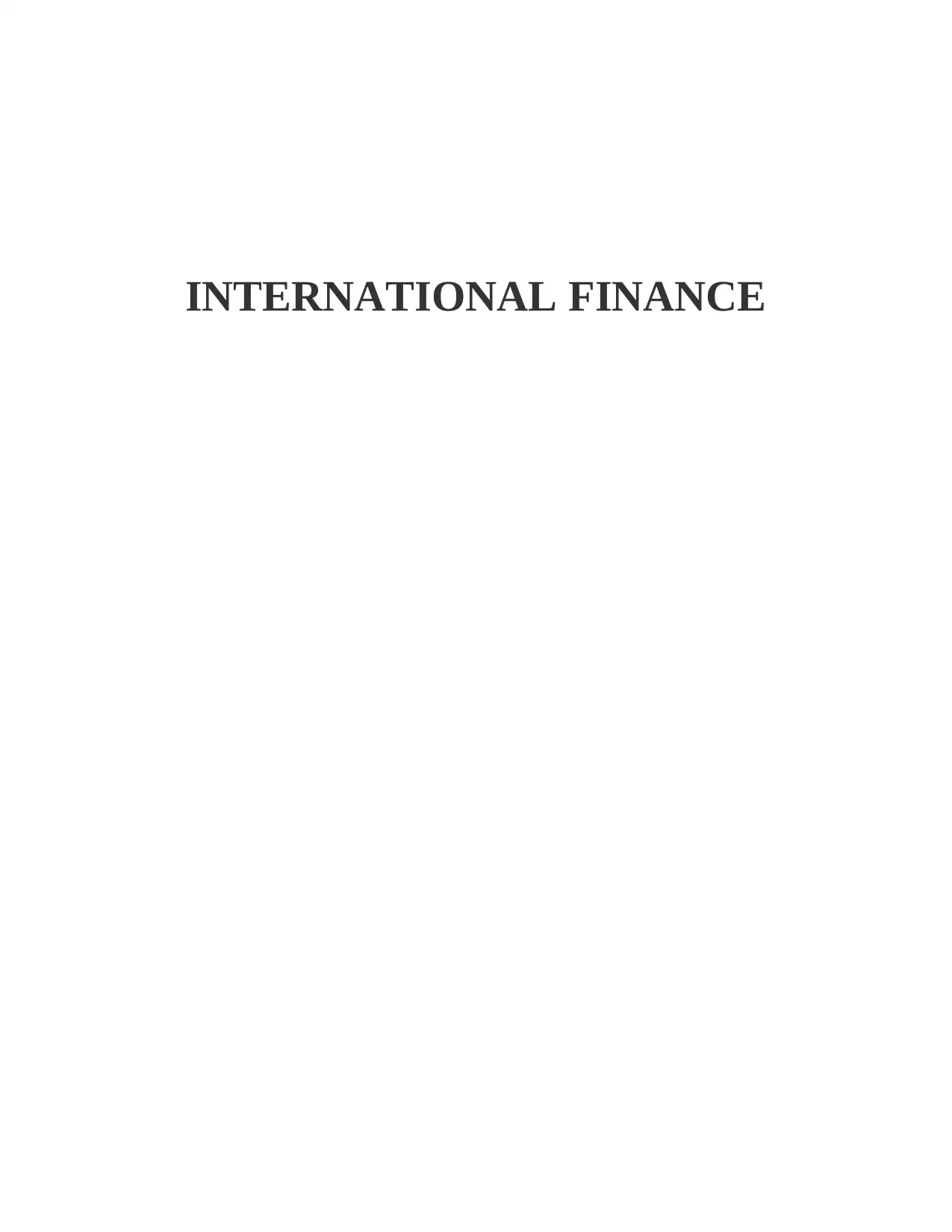
INTERNATIONAL FINANCE
Paraphrase This Document
Need a fresh take? Get an instant paraphrase of this document with our AI Paraphraser
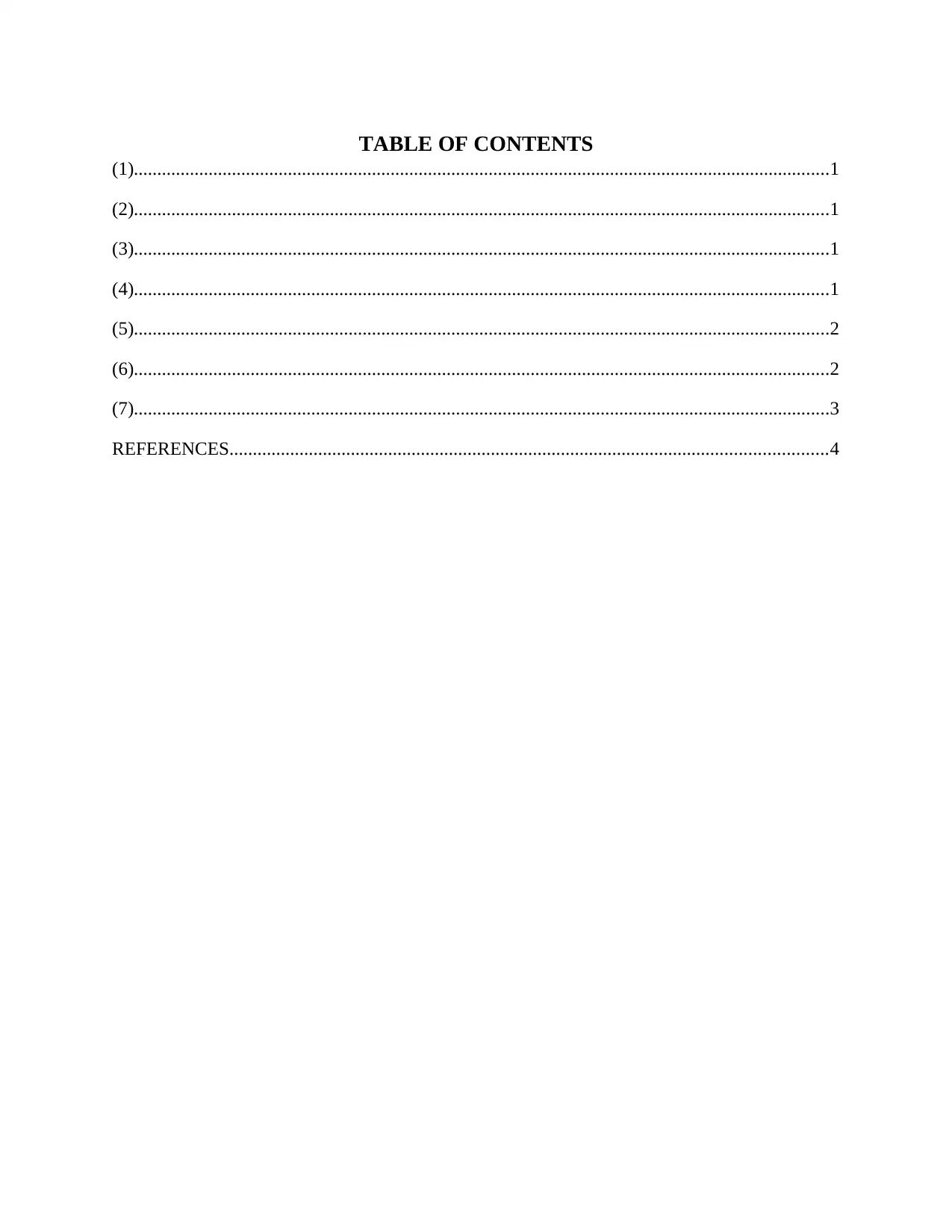
TABLE OF CONTENTS
(1).....................................................................................................................................................1
(2).....................................................................................................................................................1
(3).....................................................................................................................................................1
(4).....................................................................................................................................................1
(5).....................................................................................................................................................2
(6).....................................................................................................................................................2
(7).....................................................................................................................................................3
REFERENCES................................................................................................................................4
(1).....................................................................................................................................................1
(2).....................................................................................................................................................1
(3).....................................................................................................................................................1
(4).....................................................................................................................................................1
(5).....................................................................................................................................................2
(6).....................................................................................................................................................2
(7).....................................................................................................................................................3
REFERENCES................................................................................................................................4
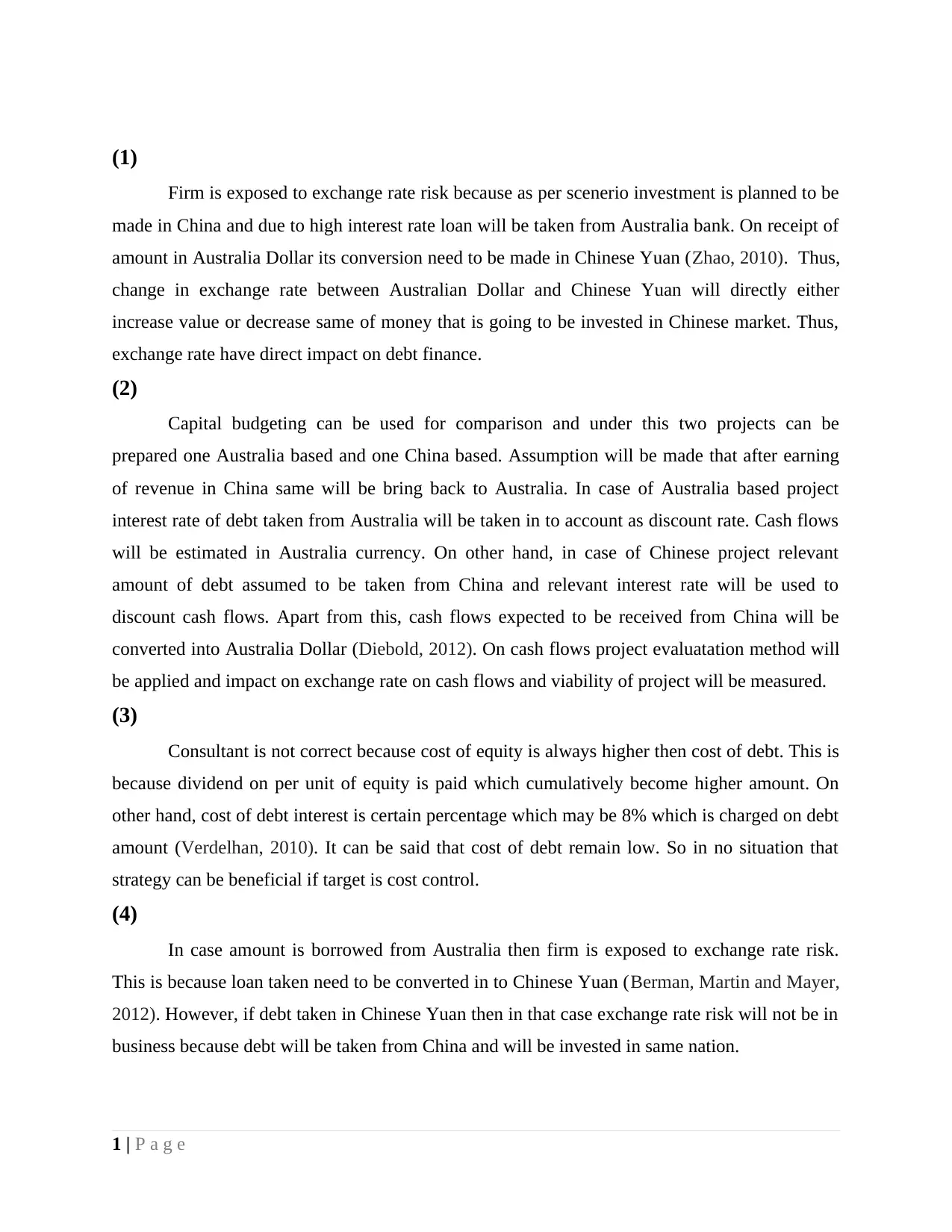
(1)
Firm is exposed to exchange rate risk because as per scenerio investment is planned to be
made in China and due to high interest rate loan will be taken from Australia bank. On receipt of
amount in Australia Dollar its conversion need to be made in Chinese Yuan (Zhao, 2010). Thus,
change in exchange rate between Australian Dollar and Chinese Yuan will directly either
increase value or decrease same of money that is going to be invested in Chinese market. Thus,
exchange rate have direct impact on debt finance.
(2)
Capital budgeting can be used for comparison and under this two projects can be
prepared one Australia based and one China based. Assumption will be made that after earning
of revenue in China same will be bring back to Australia. In case of Australia based project
interest rate of debt taken from Australia will be taken in to account as discount rate. Cash flows
will be estimated in Australia currency. On other hand, in case of Chinese project relevant
amount of debt assumed to be taken from China and relevant interest rate will be used to
discount cash flows. Apart from this, cash flows expected to be received from China will be
converted into Australia Dollar (Diebold, 2012). On cash flows project evaluatation method will
be applied and impact on exchange rate on cash flows and viability of project will be measured.
(3)
Consultant is not correct because cost of equity is always higher then cost of debt. This is
because dividend on per unit of equity is paid which cumulatively become higher amount. On
other hand, cost of debt interest is certain percentage which may be 8% which is charged on debt
amount (Verdelhan, 2010). It can be said that cost of debt remain low. So in no situation that
strategy can be beneficial if target is cost control.
(4)
In case amount is borrowed from Australia then firm is exposed to exchange rate risk.
This is because loan taken need to be converted in to Chinese Yuan (Berman, Martin and Mayer,
2012). However, if debt taken in Chinese Yuan then in that case exchange rate risk will not be in
business because debt will be taken from China and will be invested in same nation.
1 | P a g e
Firm is exposed to exchange rate risk because as per scenerio investment is planned to be
made in China and due to high interest rate loan will be taken from Australia bank. On receipt of
amount in Australia Dollar its conversion need to be made in Chinese Yuan (Zhao, 2010). Thus,
change in exchange rate between Australian Dollar and Chinese Yuan will directly either
increase value or decrease same of money that is going to be invested in Chinese market. Thus,
exchange rate have direct impact on debt finance.
(2)
Capital budgeting can be used for comparison and under this two projects can be
prepared one Australia based and one China based. Assumption will be made that after earning
of revenue in China same will be bring back to Australia. In case of Australia based project
interest rate of debt taken from Australia will be taken in to account as discount rate. Cash flows
will be estimated in Australia currency. On other hand, in case of Chinese project relevant
amount of debt assumed to be taken from China and relevant interest rate will be used to
discount cash flows. Apart from this, cash flows expected to be received from China will be
converted into Australia Dollar (Diebold, 2012). On cash flows project evaluatation method will
be applied and impact on exchange rate on cash flows and viability of project will be measured.
(3)
Consultant is not correct because cost of equity is always higher then cost of debt. This is
because dividend on per unit of equity is paid which cumulatively become higher amount. On
other hand, cost of debt interest is certain percentage which may be 8% which is charged on debt
amount (Verdelhan, 2010). It can be said that cost of debt remain low. So in no situation that
strategy can be beneficial if target is cost control.
(4)
In case amount is borrowed from Australia then firm is exposed to exchange rate risk.
This is because loan taken need to be converted in to Chinese Yuan (Berman, Martin and Mayer,
2012). However, if debt taken in Chinese Yuan then in that case exchange rate risk will not be in
business because debt will be taken from China and will be invested in same nation.
1 | P a g e
⊘ This is a preview!⊘
Do you want full access?
Subscribe today to unlock all pages.

Trusted by 1+ million students worldwide
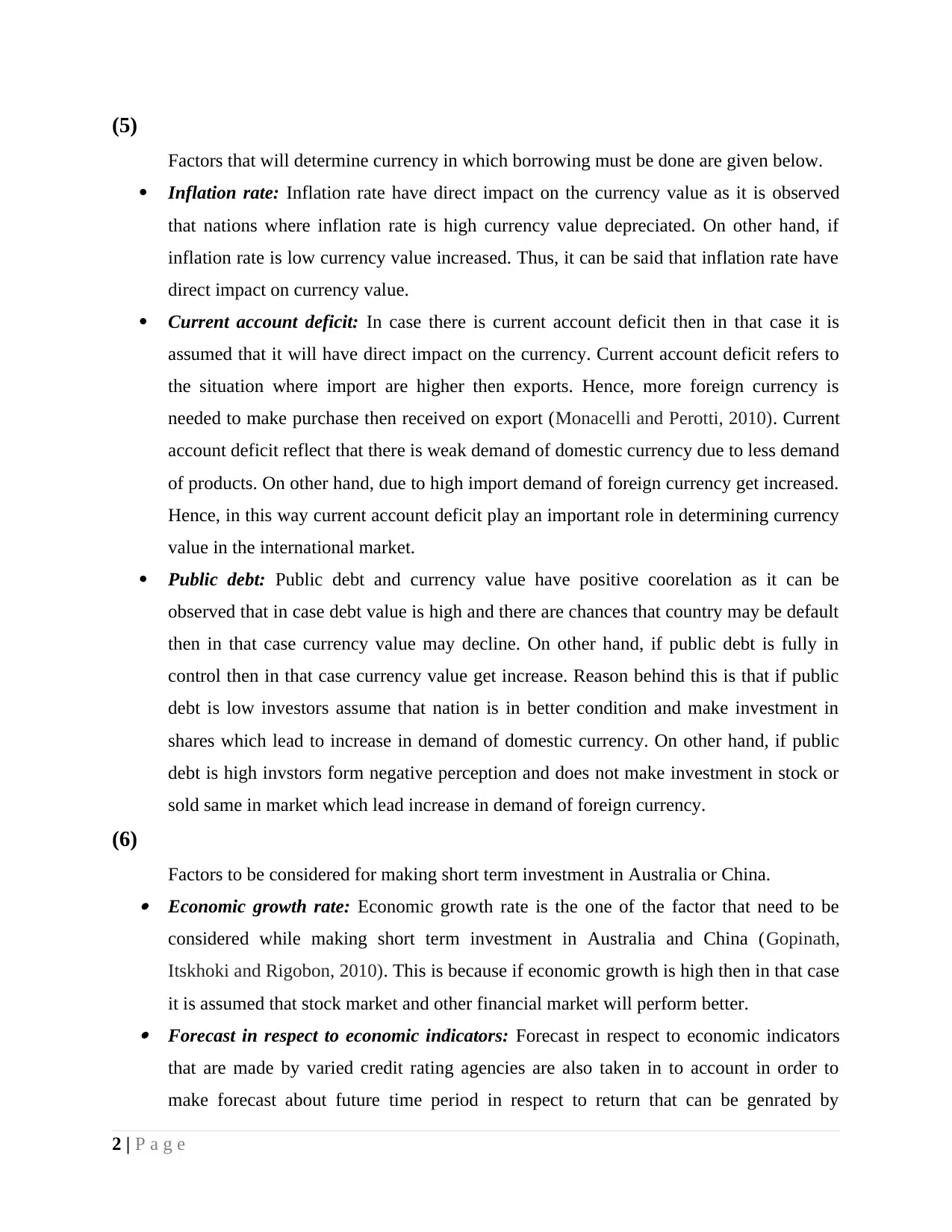
(5)
Factors that will determine currency in which borrowing must be done are given below.
Inflation rate: Inflation rate have direct impact on the currency value as it is observed
that nations where inflation rate is high currency value depreciated. On other hand, if
inflation rate is low currency value increased. Thus, it can be said that inflation rate have
direct impact on currency value.
Current account deficit: In case there is current account deficit then in that case it is
assumed that it will have direct impact on the currency. Current account deficit refers to
the situation where import are higher then exports. Hence, more foreign currency is
needed to make purchase then received on export (Monacelli and Perotti, 2010). Current
account deficit reflect that there is weak demand of domestic currency due to less demand
of products. On other hand, due to high import demand of foreign currency get increased.
Hence, in this way current account deficit play an important role in determining currency
value in the international market.
Public debt: Public debt and currency value have positive coorelation as it can be
observed that in case debt value is high and there are chances that country may be default
then in that case currency value may decline. On other hand, if public debt is fully in
control then in that case currency value get increase. Reason behind this is that if public
debt is low investors assume that nation is in better condition and make investment in
shares which lead to increase in demand of domestic currency. On other hand, if public
debt is high invstors form negative perception and does not make investment in stock or
sold same in market which lead increase in demand of foreign currency.
(6)
Factors to be considered for making short term investment in Australia or China. Economic growth rate: Economic growth rate is the one of the factor that need to be
considered while making short term investment in Australia and China (Gopinath,
Itskhoki and Rigobon, 2010). This is because if economic growth is high then in that case
it is assumed that stock market and other financial market will perform better. Forecast in respect to economic indicators: Forecast in respect to economic indicators
that are made by varied credit rating agencies are also taken in to account in order to
make forecast about future time period in respect to return that can be genrated by
2 | P a g e
Factors that will determine currency in which borrowing must be done are given below.
Inflation rate: Inflation rate have direct impact on the currency value as it is observed
that nations where inflation rate is high currency value depreciated. On other hand, if
inflation rate is low currency value increased. Thus, it can be said that inflation rate have
direct impact on currency value.
Current account deficit: In case there is current account deficit then in that case it is
assumed that it will have direct impact on the currency. Current account deficit refers to
the situation where import are higher then exports. Hence, more foreign currency is
needed to make purchase then received on export (Monacelli and Perotti, 2010). Current
account deficit reflect that there is weak demand of domestic currency due to less demand
of products. On other hand, due to high import demand of foreign currency get increased.
Hence, in this way current account deficit play an important role in determining currency
value in the international market.
Public debt: Public debt and currency value have positive coorelation as it can be
observed that in case debt value is high and there are chances that country may be default
then in that case currency value may decline. On other hand, if public debt is fully in
control then in that case currency value get increase. Reason behind this is that if public
debt is low investors assume that nation is in better condition and make investment in
shares which lead to increase in demand of domestic currency. On other hand, if public
debt is high invstors form negative perception and does not make investment in stock or
sold same in market which lead increase in demand of foreign currency.
(6)
Factors to be considered for making short term investment in Australia or China. Economic growth rate: Economic growth rate is the one of the factor that need to be
considered while making short term investment in Australia and China (Gopinath,
Itskhoki and Rigobon, 2010). This is because if economic growth is high then in that case
it is assumed that stock market and other financial market will perform better. Forecast in respect to economic indicators: Forecast in respect to economic indicators
that are made by varied credit rating agencies are also taken in to account in order to
make forecast about future time period in respect to return that can be genrated by
2 | P a g e
Paraphrase This Document
Need a fresh take? Get an instant paraphrase of this document with our AI Paraphraser
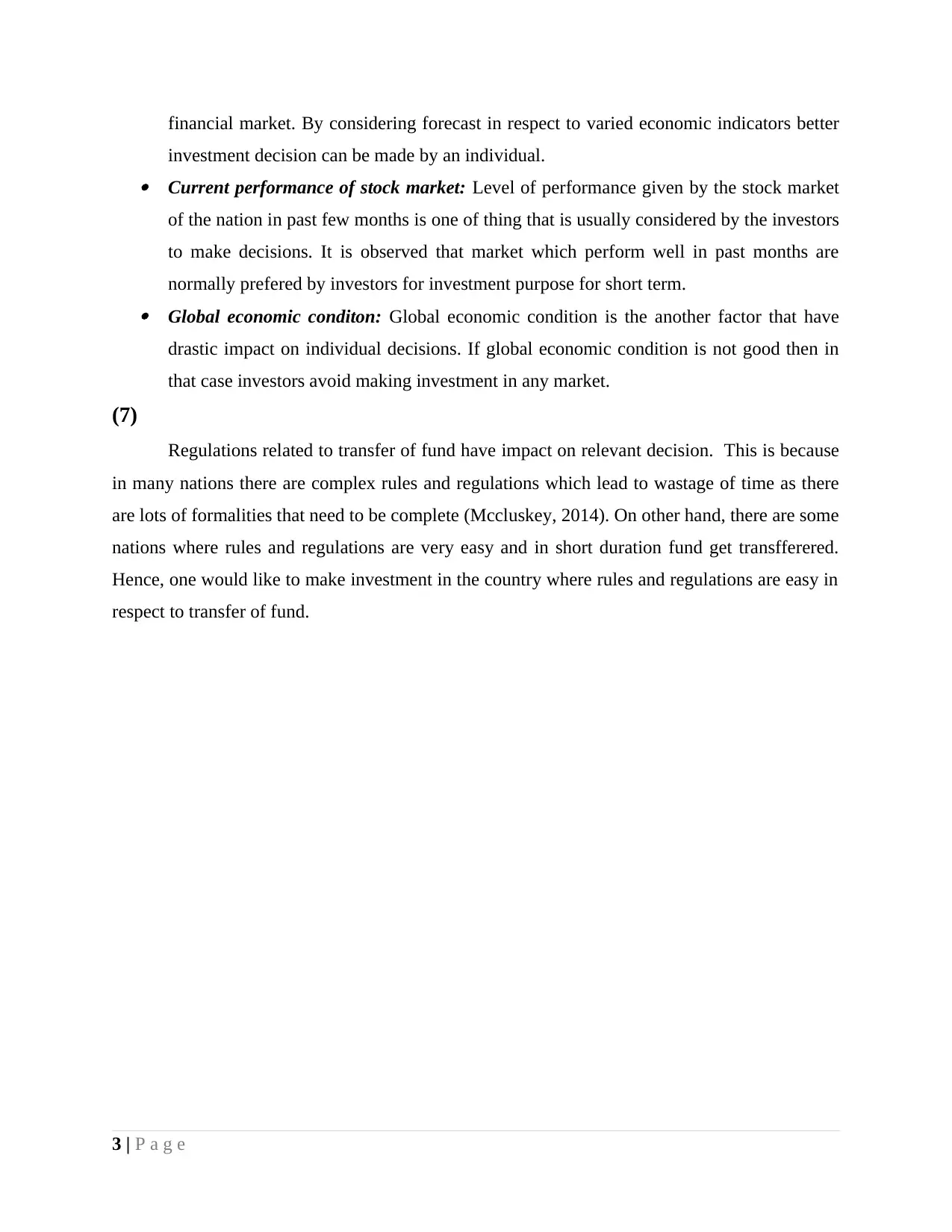
financial market. By considering forecast in respect to varied economic indicators better
investment decision can be made by an individual. Current performance of stock market: Level of performance given by the stock market
of the nation in past few months is one of thing that is usually considered by the investors
to make decisions. It is observed that market which perform well in past months are
normally prefered by investors for investment purpose for short term. Global economic conditon: Global economic condition is the another factor that have
drastic impact on individual decisions. If global economic condition is not good then in
that case investors avoid making investment in any market.
(7)
Regulations related to transfer of fund have impact on relevant decision. This is because
in many nations there are complex rules and regulations which lead to wastage of time as there
are lots of formalities that need to be complete (Mccluskey, 2014). On other hand, there are some
nations where rules and regulations are very easy and in short duration fund get transfferered.
Hence, one would like to make investment in the country where rules and regulations are easy in
respect to transfer of fund.
3 | P a g e
investment decision can be made by an individual. Current performance of stock market: Level of performance given by the stock market
of the nation in past few months is one of thing that is usually considered by the investors
to make decisions. It is observed that market which perform well in past months are
normally prefered by investors for investment purpose for short term. Global economic conditon: Global economic condition is the another factor that have
drastic impact on individual decisions. If global economic condition is not good then in
that case investors avoid making investment in any market.
(7)
Regulations related to transfer of fund have impact on relevant decision. This is because
in many nations there are complex rules and regulations which lead to wastage of time as there
are lots of formalities that need to be complete (Mccluskey, 2014). On other hand, there are some
nations where rules and regulations are very easy and in short duration fund get transfferered.
Hence, one would like to make investment in the country where rules and regulations are easy in
respect to transfer of fund.
3 | P a g e

REFERENCES
Books and journals
Zhao, H., 2010. Dynamic relationship between exchange rate and stock price: Evidence from
China. Research in International Business and Finance. 24(2). pp.103-112.
Diebold, F.X., 2012. Empirical modeling of exchange rate dynamics. Springer Science &
Business Media.
Verdelhan, A., 2010. A habit‐based explanation of the exchange rate risk premium. The Journal
of Finance. 65(1). pp.123-146.
Berman, N., Martin, P. and Mayer, T., 2012. How do different exporters react to exchange rate
changes?. The Quarterly Journal of Economics. 127(1). pp.437-492.
Monacelli, T. and Perotti, R., 2010. Fiscal policy, the real exchange rate and traded goods. The
Economic Journal. 120(544). pp.437-461.
Gopinath, G., Itskhoki, O. and Rigobon, R., 2010. Currency choice and exchange rate pass-
through. American Economic Review. 100(1). pp.304-36.
Online
Mccluskey, M., 2014. [Online]. New rules for international fund transfers. Available through:<
https://www.bankrate.com/banking/shedding-light-on-international-fund-transfers/>.
4 | P a g e
Books and journals
Zhao, H., 2010. Dynamic relationship between exchange rate and stock price: Evidence from
China. Research in International Business and Finance. 24(2). pp.103-112.
Diebold, F.X., 2012. Empirical modeling of exchange rate dynamics. Springer Science &
Business Media.
Verdelhan, A., 2010. A habit‐based explanation of the exchange rate risk premium. The Journal
of Finance. 65(1). pp.123-146.
Berman, N., Martin, P. and Mayer, T., 2012. How do different exporters react to exchange rate
changes?. The Quarterly Journal of Economics. 127(1). pp.437-492.
Monacelli, T. and Perotti, R., 2010. Fiscal policy, the real exchange rate and traded goods. The
Economic Journal. 120(544). pp.437-461.
Gopinath, G., Itskhoki, O. and Rigobon, R., 2010. Currency choice and exchange rate pass-
through. American Economic Review. 100(1). pp.304-36.
Online
Mccluskey, M., 2014. [Online]. New rules for international fund transfers. Available through:<
https://www.bankrate.com/banking/shedding-light-on-international-fund-transfers/>.
4 | P a g e
⊘ This is a preview!⊘
Do you want full access?
Subscribe today to unlock all pages.

Trusted by 1+ million students worldwide
1 out of 6
Related Documents
Your All-in-One AI-Powered Toolkit for Academic Success.
+13062052269
info@desklib.com
Available 24*7 on WhatsApp / Email
![[object Object]](/_next/static/media/star-bottom.7253800d.svg)
Unlock your academic potential
Copyright © 2020–2025 A2Z Services. All Rights Reserved. Developed and managed by ZUCOL.





